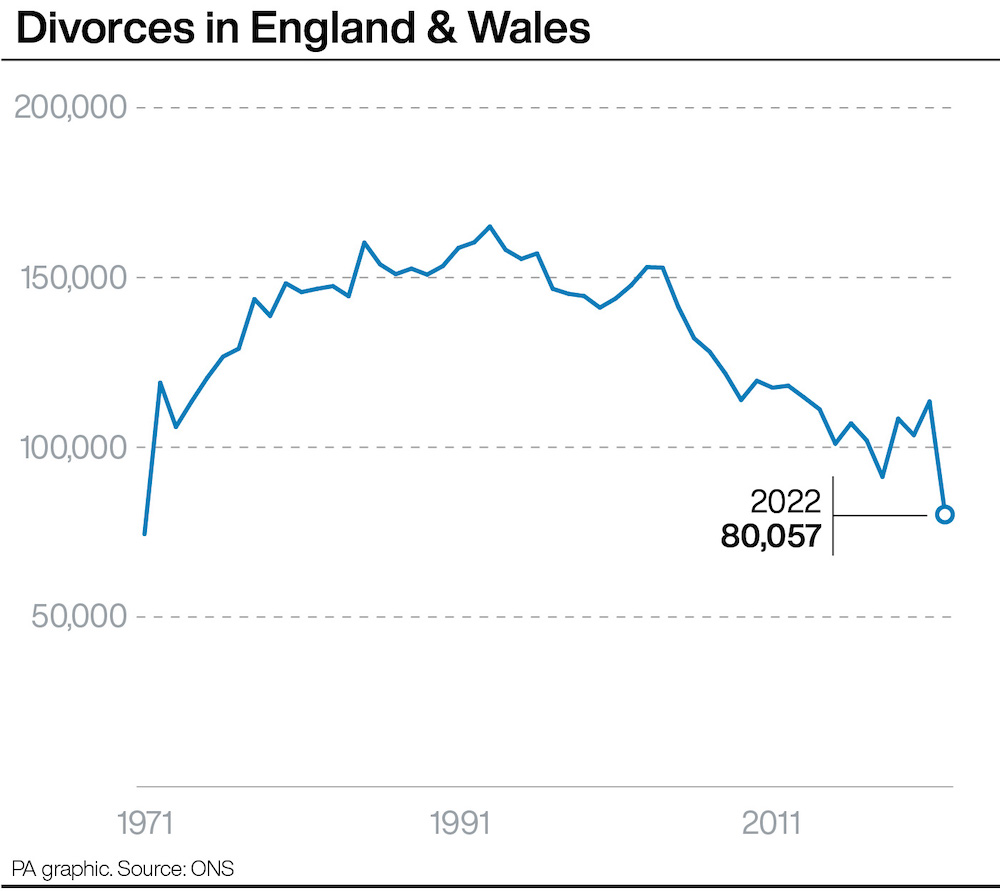Divorce rates at lowest level in decades

Divorces granted in England and Wales reached their lowest level for 50 years, according to the latest statistics.
Legal experts have cited the cost-of-living crisis as a possible reason, with couples holding off because of the financial challenges of legal separation.
There were 80,057 divorces granted in the two nations in 2022, according to the Office for National Statistics which also said it was the lowest number of divorces since 1971.
The 2022 figure is down by more than a quarter (29.5%) compared with 2021, when there were 113,505 divorces granted.
There were a total of 78,759 opposite-sex divorces in 2022, the lowest number since 1971 when there were 74,437 divorces.
In April 2022 the Divorce, Dissolution and Separation Act came into effect, reforming the legal requirements and process for divorce.
The changes were intended to reduce the potential for conflict between divorcing couples and help them avoid the “blame game”, allowing them to end their marriage jointly and remove the ability to make allegations about the conduct of a spouse.
The Act also introduced new mandatory waiting periods and the ONS said the lower number of divorces seen in 2022 “may partially reflect the introduction of new minimum waiting periods, meaning that divorces applied for after 6 April 2022 may take longer to reach final order”.

Legal experts described the drop in divorces as surprising.
Sarah Jane Boon, partner at Charles Russell Speechlys, said: “It was widely thought amongst family law professionals that we’d see a significant jump in divorce enquiries and applications.”
She added that “financial challenges related to the start of the cost-of-living crisis is also a likely contributor to the fall in divorce rates, as many couples may have considered the economic benefits of staying together”.
Katie O’Callaghan, partner at Boodle Hatfield, said: “This is an unprecedented decrease potentially reflecting the general sense of economic uncertainty we are currently experiencing.
“The strain that the cost of living crisis and rising inflation has had on families cannot be underestimated.
“Many are cautious to make significant decisions, particularly those that are likely to adversely impact their financial security even more in times of economic turmoil and uncertainty.”
Opposite-sex couples divorcing in 2022 had been married for an average of 12.9 years while for male and female same-sex couples this was 7.5 and 6.3 years respectively.
Divorce rates in 2022 were 6.7 for men and 6.6 for women per 1,000 of the male or female married population.
These were lower than rates in 2021, when it was 9.5 for men and 9.4 for women per 1,000 of the married population.
The number of civil partnership dissolutions fell to the lowest recorded since 2010.
In 2022 there were 525 civil partnership dissolutions, including same-sex and opposite-sex couples, a 22.8% decrease compared with 2021 when there were 680 dissolutions.
There were 7,394 divorces and 54 dissolutions – 9.2% of all divorces and 10.3% of all dissolutions – granted under the new Act.
More than a quarter (28.8%) of these new-law divorces, and 61.1% of new-law dissolutions, were granted under joint application, the ONS said.
Kerry Gadsdon from the ONS, said: “This year is most notable for seeing the introduction of legislative change, allowing couples to make a joint application for the first time, an approach taken in well over half of dissolutions and over a quarter of divorces made since the new Act.”
Support our Nation today
For the price of a cup of coffee a month you can help us create an independent, not-for-profit, national news service for the people of Wales, by the people of Wales.






